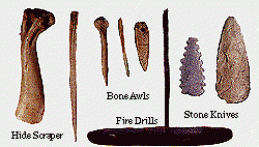Instruments of Science Promote Human Existence and Knowledge

Primitive Human Tools of Stones and Bone
Instruments are tools that help people accomplish what they could not do without that instrument or tool. Simple tools of humans were stone knives, arrows and bone awls and hide scrapers.These tools enable people to do tasks that are difficult or impossible otherwise. Arrowheads of stone were sharp enough for hunting and protection in battles against others. Bones and stones were sharpened and shaped to form knives, axes, arrows and awls. Various tools were used to cut and shape wood, remove hair and hide from game animals, battle enemies.
Instruments make work and labor easier, but any tool may reveal things previously hidden from sight. The stone or the rock that crushes a coconut quickly reveals white, edible human food. Today, a sharp axe does the job most quickly. The same axe that is used to cut trees soon can help to reveal the rings and circles in the inner trunk of the tree that indicate the approximate age of the tree. Some instruments promote knowledge, as do telescopes and microscopes. Some tools such as the plow, the tiller and the scythe promote food growth and harvesting. Thus, tools and instruments can promote life, survival and the existence of humans, or expand human understanding.
More modern tools today include: screwdrivers, hammers, circular and reciprocating saws. files, motors, and associated tool objects such as nails, screws, staples to name just a few. Tools simplify tasks, reduce labor and contribute to a better and healthier life. Ultimately, good tools promote human existence.
Science Tools are Speciality Tools
Many of the first scientific tools took months or years to develop. In the beginning science tools are always simple. As scientists learn more and more, they become better at developing the tools they have.
Consider the simple science tools or instruments known as a magnifiers, or even spectacles (eyeglasses). Soon the art of grinding and polishing glass and lenses became refined and expanded into the art of making and producing telescopes and more powerful microscopes. Although there is a big difference among Galielo's, Newton's and Hubble's telescopes, they all rely on the same principles of physics, and the electromagnetic spectrum. Leeuwenhoek's microscopes, produced in the 1600s, were progressively developed and enhanced to produce the excellent phase and interference microscopes of modern times.
Along the way here, one can see the simplicity of science as when simple inoculation wires and loops, bunsen burners, Petri dishes, slides and stains are used in microbiology. Today, science has produced complex electronic, medical devices, and amazing antibodies tagged with fluorescent markers that can be used to locate or track cells and reveal various tissues and organs inside the body.
VISIT Our Science Super School Store
All the Written Material within Site is Copyrighted 2010 and Owned by Dr. Donald Reinhardt, and this original material is protected legally by this copyright notice and by the Digital Millennium Act. None of this original material may be copied or reproduced without the expressed written consent of the author. The author is a Freelance Science writer, and is available for specific assignments for those who are interested – by contacting adminstrator@sciencesuperchool.com. Other questions related to this teaching site should be directed to teacher@sciencesuperschool.com.
Instruments make work and labor easier, but any tool may reveal things previously hidden from sight. The stone or the rock that crushes a coconut quickly reveals white, edible human food. Today, a sharp axe does the job most quickly. The same axe that is used to cut trees soon can help to reveal the rings and circles in the inner trunk of the tree that indicate the approximate age of the tree. Some instruments promote knowledge, as do telescopes and microscopes. Some tools such as the plow, the tiller and the scythe promote food growth and harvesting. Thus, tools and instruments can promote life, survival and the existence of humans, or expand human understanding.
More modern tools today include: screwdrivers, hammers, circular and reciprocating saws. files, motors, and associated tool objects such as nails, screws, staples to name just a few. Tools simplify tasks, reduce labor and contribute to a better and healthier life. Ultimately, good tools promote human existence.
Science Tools are Speciality Tools
Many of the first scientific tools took months or years to develop. In the beginning science tools are always simple. As scientists learn more and more, they become better at developing the tools they have.
Consider the simple science tools or instruments known as a magnifiers, or even spectacles (eyeglasses). Soon the art of grinding and polishing glass and lenses became refined and expanded into the art of making and producing telescopes and more powerful microscopes. Although there is a big difference among Galielo's, Newton's and Hubble's telescopes, they all rely on the same principles of physics, and the electromagnetic spectrum. Leeuwenhoek's microscopes, produced in the 1600s, were progressively developed and enhanced to produce the excellent phase and interference microscopes of modern times.
Along the way here, one can see the simplicity of science as when simple inoculation wires and loops, bunsen burners, Petri dishes, slides and stains are used in microbiology. Today, science has produced complex electronic, medical devices, and amazing antibodies tagged with fluorescent markers that can be used to locate or track cells and reveal various tissues and organs inside the body.
VISIT Our Science Super School Store
All the Written Material within Site is Copyrighted 2010 and Owned by Dr. Donald Reinhardt, and this original material is protected legally by this copyright notice and by the Digital Millennium Act. None of this original material may be copied or reproduced without the expressed written consent of the author. The author is a Freelance Science writer, and is available for specific assignments for those who are interested – by contacting adminstrator@sciencesuperchool.com. Other questions related to this teaching site should be directed to teacher@sciencesuperschool.com.